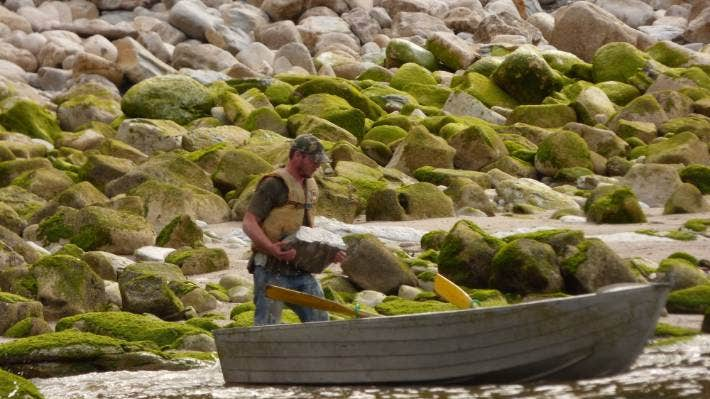The whale specimen, a popular local attraction, was allegedly removed from a riverbed in broad daylight by two guys armed with a stone saw and chisel.
The preserved ribs, as well as vertebrae of a whale, have just been trapped in a sandstone ledge on the banks of the Little Whanganui River on New Zealand's isolated West Coast for roughly 23 million years.
Two guys, equipped with a rock saw and chisel, cut a fossil out of the rock in broad daylight before rowing it down the river to a trailer, where a woman was waiting and drove away. Tom Horncastle, who resides near the river, claimed he heard the buzzing of a noisy chain had seen that afternoon. He initially assumed that people were chopping firewood on the seashore. But when he got down to the river, he noticed people cutting out the four-square-foot specimen, a popular part of the surrounding ecology.
He approached the guys, who were escorted by a youngster, and inquired about whatever they were doing. Mr. Horncastle described one of the males as "extremely nervous." The guy seemed rather angry when he initially approached them, but once Mr. Horncastle indicated he did not intend to fight, the guy seemed to be okay. Mr. Horncastle said the individuals claimed to have authorization from the neighboring Maori tribe, or iwi, to take the fossil and claimed to be doing so to safeguard it, as per Stuff, a New Zealand news platform.
Local's Valued Fossil Allegedly Stolen
Locals on the site confronted the group but were unable to notify authorities in enough time to prevent the remains from being hauled away. It's unknown whether the persons who took the fossil breached any laws. Residents of neighboring Karamea, a settlement of around 350 people approximately 60 miles to the north of Westport, were enraged.
The fossil has always been easy to find, needing excellent weather, no floods, and a low tide. The fossils were valued by the local population, with many people who have visited the bones throughout their lives. It is likely to be the remains of an archaic baleen whale that lived approximately 23 million years ago, during the late Oligocene or early Miocene epoch.
Dr. Justin W. Adams, an assistant professor of morphology and paleontology at Australia's Monash University mentioned to Newsweek that fossils of aquatic mammals (among other species) are rather frequent over New Zealand shorelines. Because of changes in ocean levels throughout time, old beach and coast sediments that were previously cemented (becoming hard rock-carrying fossils) are now being uncovered by tidal erosion. As a result, it's not unusual to come across fossil bits in exposures (or loose rock in coastal regions). Larger examples, such as these, are more noticeable (as they were well-known to the community).
Unauthorized Remains Removal
Despite the local community's unhappiness, it is questionable if this behavior was legally criminal. In New Zealand, the legality of the private collecting and domestic trading of fossils stolen from public property is a little hazy, according to Kerry Walton from the University of Otago, in an interview with Newsweek.
He does not know if the circumstances surrounding the removal of this particular fossil were legal, well-informed, well-executed, or performed in good faith based on the facts available to him. The removal of degrading fossils from coastal platforms may be the only option to conserve them in the long run, allowing for research and community involvement with the sample for decades to come, as added by the Ph.D. candidate.
Adams emphasized that removing such massive chunks of rock loses the scientific community money since any possible discoveries or data gathered from the fossils are lost. This is why many scientists are opposed to the sale of fossil remains to private owners: any future research on that specimen, therefore, is jeopardized.

A group of people took a 23-million-year-old fossil from a West Coast river, leaving locals furious.
Market for Stolen Fossils
Furthermore, if the party who removed the bones was not skilled in removal procedures, they may have harmed the fossil. Paleontologists and archaeologists are plagued by fossil thieves; for example, 250 million-year-old fossils were purportedly taken from Capitol Reef National Park in Utah in May of this year. As per Adams, this is due to a collector market that encourages this type of thievery.
In the most extreme situation, this will disappear from corporate collectors' markets. So, for example, if such fossils included crucial information on whale evolution or New Zealand cetacean ecosystems, it is now utterly lost to science. The 'best' case scenario is that everything identified as important is eventually donated to a museum to preserve. However, as previously stated, one loses all of the crucial contextual information that is necessary to preserve scientific significance.
Paleontologists are frequently under-resourced to collect, maintain, and preserve a large number of deteriorating sites the earth has. Some specimens and data are frequently better than nothing at all, even if they do not meet present data and curation criteria, as concluded by Adams.
RELATED ARTICLE: Ancient Sharks Loved to Eat Noses of Sperm Whales Due to High-Fat Content, Fossil Records Reveal
Check out more news and information on Paleontology in Science Times.














